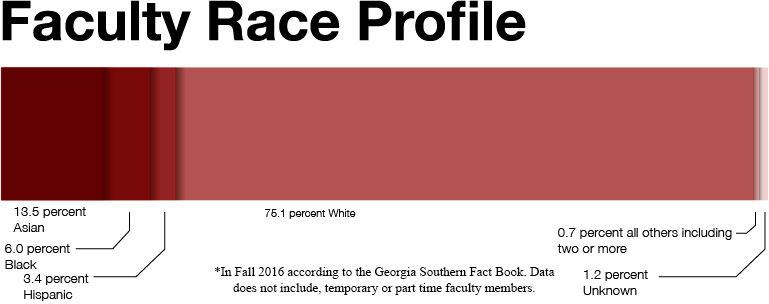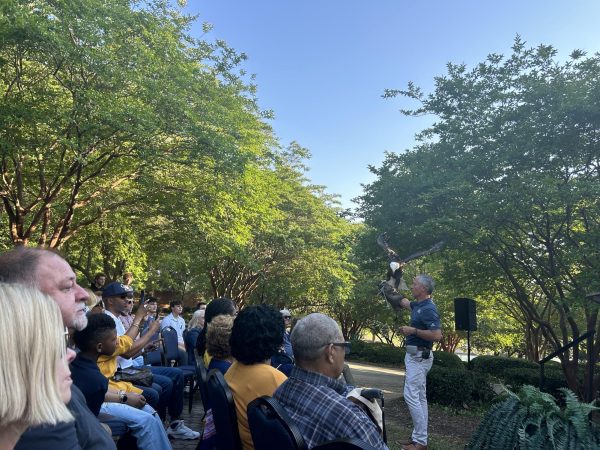In pursuit of equality
March 8, 2018
Nearly two and a half years ago, the Georgia Southern University (GS) chapter of the NAACP held a protest in the Russell Union in response to remarks made by a student on Twitter the organization felt were racially motivated.
In addition to a sit in at the student union, the GS NAACP released a list of demands to the university, one of which called for GS to raise the number of black professors at GS to 12 percent by the year 2020.
As part of the consolidation, Maxine Bryant, PhD. has been named the Interim Associate Provost of Diversity and Faculty Development, of the new university, tasked with tackling these issues for the new institution going forward.
By the numbers
At the time of the demands, black professors made up only 3.1 percent of professors at GS, and totaled only 6.2 percent of all full-time regular academic faculty, a term that encompasses professors, associate professors, lecturers, assistant professors and instructors, according to the Georgia Southern Fact Book.
In the fall of 2016, the percentage of black professors increased to 3.4 percent, however the total number of black full-time regular academic faculty dropped from 46 to 44 between 2015 and 2016, decreasing the percentage from 6.2 to 6.0 percent, according to the GS Fact Book.
Georgia State boasted nearly triple that amount in the Fall of 2015, with a total of 116 black full-time instructional faculty, making up 9.3 percent of said category, according to the Georgia State Fact Book. Valdosta State, while closer to GS had black faculty members make up 5.3 percent of their total full-time instructional faculty, according to the Valdosta State Fact Book.
White instructional faculty made up 75.1 percent of full-time regular academic faculty in the Fall of 2016, with Asian instructors making up the second highest percentage at 13.5 percent, according to the GS Fact Book.
Women represented 48.3 percent (353) of full-time regular academic faculty in the Fall of 2016 as well, a slight increase from the previous year, 47.8 percent (355), according to the GS Fact Book.
{{tncms-inline content=”<p>&ldquo;Research has shown that it is very helpful for students to see representation of themselves in the classroom and in higher level positions, in the administration, of a university. Those persons serve as role models and mentors, and examples of what we call success.&rdquo; – Maxine Bryant, PhD., Interim Associate Provost of Diversity and Faculty Development</p>” id=”58dcdc04-b0a7-4ee9-b7d5-69967115205b” style-type=”quote” title=”Bryant” type=”relcontent”}}
The Diversity Council
The President’s Diversity Advisory Council was created in hopes of addressing these issues for the new university. The council announced plans to conduct a SWOT analysis on Statesboro, Liberty and Hinesville campuses earlier this year, to help the council assess what problems to focus on most quickly. Bryant stressed the importance of having a diverse faculty, not only for the university, but the academic success of students as well.
“Research has shown that it is very helpful for students to see representation of themselves in the classroom and in higher level positions, in the administration, of a university,” Bryant said in a phone interview. “Those persons serve as role models and mentors, and examples of what we call success.”
Bryant continued on the emphasize the importance of underrepresented students having a mentor who may have shared life experiences and has overcome similar struggles. Bryant also believes that students who aren’t from under represented cultures would benefit from these interactions as well.
“For [non-underrepresented students] to know, and see, and connect with professors and administration at the university, so that they can see barriers have been broken, and they can broaden their connectivity, with people who may not look like them, and gain an appreciation,” Bryant said.
Bryant added that she believes these kinds of interactions may lead to a more open and accepting environment in the future. Bryant also stated that another purpose of the SWOT analyses is to get an understanding of what faculty and staff believe are the most important areas to improve in for the new institution.
“Faculty also recognize the need for having an inclusive environment on campus, so that all people feel safe on all three campuses,” Bryant said. “This SWOT analysis hopefully will inform what we need to do in terms of training.”
Although new to the position, Bryant mentioned that some of the problems she’s heard associated with recruiting diverse staff include monetary compensation, as well as the difference in culture in the south as opposed to where the applicant may have been more acclimated to.
President Hebert also asserted the importance of the new council to the consolidated university.
“[The President’s Diversity Advisory Council was created] to provide a forum for the discussion of diversity related issues, on any of our campuses. That council reports to me, so I felt it was absolutely necessary that we had a direct communication, from a group who it considering diversity issues on our campuses, to the president’s office,” Hebert said in an interview on February 28.
{{tncms-inline content=”<p>&ldquo;[The President’s Diversity Advisory Council was created] to provide a forum for the discussion of diversity related issues, on any of our campuses. That council reports to me, so I felt it was absolutely necessary that we had a direct communication, from a group who it considering diversity issues on our campuses, to the president&rsquo;s office,&rdquo; – President Hebert</p>” id=”5fd40545-795e-4979-b9f7-db669fc85c8a” style-type=”quote” title=”Hebert” type=”relcontent”}}
Getting Students Involved
As Bryant mentioned, the Diversity Council also wants to ensure that the voices and opinions of students. Iyanna Fouce, sophomore early childhood education major felt that GS currently has a moderately diverse staff.
“Yeah, I’d say [GS has] a pretty diverse staff,” Fouce said.
Fouce did make clear the importance of diversity in a university setting.
“I think having a diverse faculty makes students feel more welcome, and when they get here and see others like them it makes them feel more included,” Fouce said.
Kacey Smith, sophomore biology major, echoed this sentiment as well.
“Outside of formal education, there are life lessons to be learned and I feel like that’s where diversity plays a larger role,” Smith said.
Smith also felt like GS has a diverse staff, however she did express concerns with the amount of black professors she has seen on staff.
Ian Leonard, Enterprise Managing Editor, gaspecial@georgiasouthern.edu















